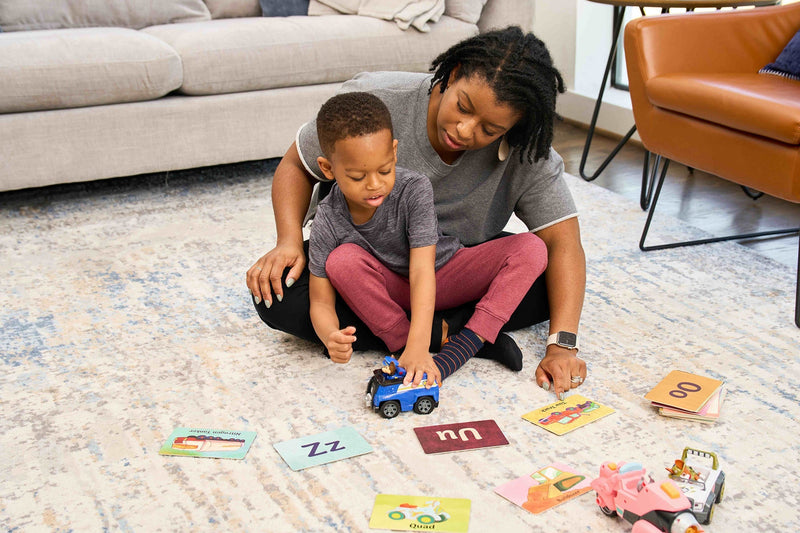So, you've decided to teach your kid how to read. You talk to friends and family, follow accounts, buy all the supplies you could possibly need, and set up the perfect space for your child's learning time.
But here's the problem: No matter what you do or how hard you try, you can't figure out how to get your child to pay attention.
And I've seen it over and over: Excited parents who feel defeated when it seems like their child wants to do anything other than learning.

If this describes you, I promise you're not alone... When I started teaching kindergarten, I couldn't figure out why my kids weren't participating in my lessons, either. But I didn't give up. And eventually, after months of trial and error, I learned the secret to a positive and productive learning time:
In order to fix a challenging behavior, you have to figure out why that behavior is happening.
In this blog post, I'll share 5 of the most common problems parents have during learning time and give you solutions that work for each specific problem.
And as you read, I want you to keep one core belief in mind:
All kids WANT to and CAN learn.
I could write a thousand blog posts on different ways to help your child learn to read. But if YOU don't believe in YOUR child- that they WANT to and CAN learn what you're teaching them- no amount of advice I give you will make a difference. And if that is your mindset, I'm probably not the right person to help you.
Now, if you do believe in your child (and your ability to teach them), this blog post will be a good place to start.
First, diagnose the root cause of the behavior.
The first and most important step in getting your child to focus on the learning time is to take a step back and understand what the problem with the learning time is. Consider very carefully (and honestly) what is and isn't working, so you know what to keep and what changes to make.
Think of it like this: You go to the doctor because of a cough. And instead of examining you and asking a series of questions to find out why you have the cough, they simply prescribe you some flu medication and hope it works. Later, you find out you don't have the flu at all. So, there's a good chance that medicine isn't going to actually work because they never diagnosed the root cause of your problem.
When it comes to solving your child's behavior challenges, there are a million different things you could try. But if you don't know what's actually causing the problem, it's unlikely that any of those solutions will help. Plus, it's likely to leave both you AND your child even more frustrated than you were when you started.
You know your child best.The good news is, you don't need anyone else to figure out what the challenge is for your child because no one knows them or how they learn better than you do.
You know what things they do and don't like. You know if there are other things that might be causing trouble during their learning time. You also have the best idea of what encourages and motivates them.
Make sure to stay objective.And while as parents we do know our children best, sometimes we can be TOO close to the problem to see it clearly. So to understand what the problem really is, it's important that we take a step back and look at the problem from objectively every angle (even when it might hurt to do so.)
And I know it's hard not to shut down, feel angry or sad, or even give up when it comes to OUR kid's behavior. But it's important to remember that none of this will help our child's behavior improve. So we have to diagnose the problem as fairly as we can to find the best solution for them.
This might not be easy.By now, you may be thinking to yourself: "Why should I take this approach when there are so many other parenting tips on the internet that seem way easier to do?"

And that's a great question. And just to be straight up with you, I think the reason a lot of those other tips seem so much easier to follow is because they usually don't work.
A lot of people tell you what you want to hear instead of what you need to hear. They're more concerned with improving their follower count than they are with improving your child's behavior. But because these tips are not as honest, they won't be as helpful.
So I'm not going to sugarcoat things for you. I'm going to be 100% honest because that's what your child deserves. So here's what's most likely going on.
The 5 Most Common Problems Parents Face During Learning Time
The most common learning time challenges fall into two general buckets: Procedure Issues and Behavioral Issues.

Procedural Issues
Any teacher will tell you that one of the most important parts of running a classroom is having strong procedures. Procedures are clear and easy-to-understand ways of doing things that we always follow.
I can't tell you how many teachers I've seen struggling with behavior problems that actually have nothing to do with the kids and everything to do with the procedures.
Often, if we fix the procedure, the challenging behavior will disappear altogether. And this is true for children of all ages, all learning styles, and all learning differences.
So what are the most common examples of bad learning procedures?
This one should be pretty easy for us to understand because, as adults, most of us follow the same routines every day. And it brings us comfort when we know exactly what to expect. So when we create routines for our little ones, we should be focused on keeping them as consistent as possible.
You might ask yourself: "Do we do the learning time at the same time, in the same place, and in the same order every day?"
Sample Routine-
Every weekday at 5:00 PM, you and your child spend 10 minutes on the living room floor working on letter sounds.
-
You spend the first minute or so reviewing the sounds they already know.
-
You spend the three minutes or so introducing 2-3 new letter sounds.
-
Then, for the last six or so minutes, they pick a toy to play a game with using the new letter sounds they just learned.
-
At the end, you celebrate their effort and do something special together.
It's also important to know that a routine that works for one child might not work for another. Maybe your child is just starting out, and 3 minutes is the longest they can focus for. Or maybe it's easier for them to focus in the morning or at the kitchen table.
Finding the routine that works best for them might take a little experimenting, but the important thing is that once you figure out what routine works, you: stick with it.
2. Confusing TeachingEven as adults, it's easy to feel overwhelmed if we're given instructions that don't make sense. The same is true for our little ones!
Ask yourself:
- Is what I'm asking my child to do easy to understand?
- Am I asking them to do too many things at once?
- Ex: "Point to the sound that says 't.'" is a lot easier to understand than: "Look at all the sounds on the table and think about what sound they make. Point to the one that says 't,' then move your toy car to it. Then say the sound."
- Do I teach them in the same way, every time?
If our lesson isn't fun and doesn't keep our child's attention, they'll probably get bored. And if they get bored, their behavior will become much more challenging as they fight to stay engaged.

Here are some questions to think about:
- Is the lesson too easy or too difficult for them?
- Are you using toys and games that are fun for them?
- Ex: My son LOVES trains, so if I'm able to work those into a lesson (or even have them watch him and celebrate him as he works,) then he's more likely to be engaged.
- Are there things in the learning space that could distract them? (favorite toys, tablets, yummy snacks, etc.)
Too much of a good thing is NOT a good thing. Even if your absolute favorite food in the world is pasta, you would probably refuse to eat it if that's all you'd been eating for 2 weeks straight. Right?
And just like how we as adults don't enjoy doing the same thing over and over, neither do our kids. So if something you're doing to engage your kid suddenly STOPS working, don't assume there's a bigger problem right away. Instead, start by adjusting the way you'reengaging them to see if it helps to keep their attention.

Behavioral Issues
Let's say you've perfected your procedures- you've got a solid routine, give clear instructions, and create an engaging lesson every time. BUT your child is STILL struggling to engage in the learning time. If this is the case, the root cause probably is a behavior issue, not just a problem with your procedures.
This could look like a bunch of different things: struggling to pay attention, refusing to listen, running out of the room, interrupting your teaching, or screaming "NO!" (to name a few.).
And while this is going to ruffle some feathers for sure, the most common cause of these behavioral issues is a child who is not used to following/meeting age-appropriate directions.
5. Inexperience Following DirectionsThis might be getting into parenting territory a little bit, and I know a lot of folks get very concerned when it comes to their kid not following directions. But if this is the problem, it's important that we're completely honest about it.

Now, I'm not going to tell you exactly what you might want to change because every family, every parent, and every child is different.
But what I am going to do, is try to help you understand what's going on in your child's brain so you can see the change you want to see.
Because if you have a child who doesn't follow directions throughout the day, they're not going to magically follow directions when it's time to learn. They've learned that even though you tell them to do one thing, they're allowed to get out of it by doing something else.
So when you try to sit down and work on learning time, you will likely see the same behavior they exhibit during other parts of the day. Meaning they're going to refuse- even if it's fun- because they're not used to doing what you tell them.
If you want to help them follow directions during learning time, they have to be in the habit of following directions outside of learning too. They have to learn that when you set an expectation, you expect them to meet it. Otherwise, they're going to take as much wiggle room as they can to NOT do what you're asking.
And if your child is struggling to follow directions, please remember: behavior issues do not say ANYTHING about our child's character OR your ability to teach them. Your child CAN do the learning time, and you CAN teach them - you just have to practice setting and reinforcing more consistent expectations for their behavior. So don't let these challenges discourage you.
If you want some extra support to address the issue head-on, I offer a bonus behavior course with the purchase of any of my reading course.
How to Improve Issues During Learning Time
At this point, your wheels are probably turning, and you should have at least some idea of which of these 5 common issues you're facing. So now what?
Well, first, we pick the exact problem we're dealing with (Routine? Instructions? Engaging lesson? Following directions?) If you try to make the lesson more engaging, but really it's that the instructions aren't clear and the routine is inconsistent, adding in fun games probably isn't going to do much.
Then, we pick 1-2 issues to address at a time- NOT all at once. For example, don't work on making the lessons more engaging until you've nailed down a solid routine. Trying to do too much too soon is going to overwhelm both you and your little one, and it'll take a lot longer to get your learning time where you want it to be.
The final (and possibly the most important) step is to commit to addressing the problem for at least a week before trying something new. Change takes time, and repetition is what's going to turn that change into a habit. Practicing this change might feel like a lot at first, but in the end, you'll be glad you did.
Things to Keep in MindThe reason this approach is effective is because I don't believe in a one-size-fits-all solution. Every child is different and has needs that are specific to them. As you're going through the process of figuring out what the problem is and how to fix it, you'll want to keep your needs and your child's specific needs at the center of your plan.
If the problem is that the lessons aren't engaging, but you hate making a mess, don't buy the sandbox to trace letter sounds (but DO think about making the learning more hands-on in a way you can handle.) If your little one can only focus for 3 minutes, don't build a 10-minute learning-time routine (But DO figure out what routine will get you the most out of those 3 minutes.)
How to Help Your Child
It doesn't matter how excited your child is about learning or how capable they are- if one of these 5 areas isn't working, the learning time is going to fall apart. But one small step at a time will get you where you want to be. Commit to making small changes consistently, and the progress you want will come.
As parents, we owe it to our kids to try and figure it out. No matter how hard this might seem, the effect this will have on your child's life will be huge. Improve the learning time, and your little one will not only become a better reader, but your relationship with your child will grow.
If you need more support, each of my courses also includes a bonus course on toddler behavior.
I'll say this again because it's true: This might not seem easy. In fact, it will probably feel very hard. But this will be worth it.









